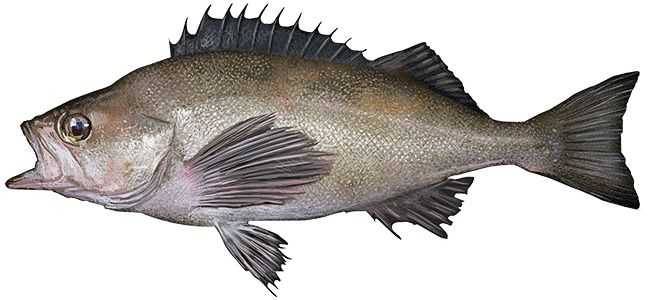Widow Rockfish

Species Details
Sebastes Entomelas
Sebastidae
Scorpaeniformes
offshore reefs, rocky areas
5 lbs.
12" - 24"
Widow Rockfish (Sebastes entomelas) Fish Description
A Widow Rockfish has an elongated, compressed body with a short head, small mouth, and curved upper profile. Its body is brassy brown, and its belly is of lighter hue with a reddish cast, while its anal and pectoral fins are black. The smaller Widow Rockfish has a lighter color with streaks of orange.
This fish matures when it reaches four years old. By that age, it can measure as long as 12.75 in. Some grow faster at three years old. This fish is also a known prey for bigger fishes like sablefish, Pacific Halibut, Sperm Whale, and even the Seabird.
Diet and Size
A young Widow Rockfish feeds on copepods, calanoids, and euphausiids, while the adult feeds on anchovies, salps, and small squids.
A mature widow rockfish is usually 16.5 inches long and can grow up to 24 in. A male Widow Rockfish grows faster than its female counterpart, but the females reach larger sizes in the long run.
Interesting Facts About the Widow Rockfish
- A Widow Rockfish have air bladders allowing them to float motionless in the water.
- This fish can live up to 60 years, though rather a rare occasion.
- A female Widow Rockfish develops and nourishes its eggs internally. Its larvae are released alive between January and February.
- Their meat has a lean, medium-fine texture and a delicate nutty flavor.
- The Widow Rockfish goes out at the shallows at night for their feeding time.
Habitat and Distribution
The Widow Rockfish is commonly found from Todos Santos Bay in Baja, California, to the Middle Albatross Bank along Kodiak Island in the Gulf of Alaska. Adult Widow Rockfishes are most abundant in Northern California and British Columbia.
Although they are mostly found in waters as deep as 462 to 693 feet, this fish species' adults are often caught in depths between 80 to 1,812 ft. They dwell mostly over rocky areas and offshore reefs, especially during the night.
A single female Widow Rockfish can produce 95,000 to up more than a million eggs in a year. Its spawning season depends on its location. Those off in the southern seas of California release their larvae between December and March, while those of British Columba release around May.
Fishing Technique: How to Catch a Widow Rockfish
There’s no specific fishing technique to catch a Widow Rockfish, but most recreational anglers use a variety of techniques depending on the location. Some use line fishing in the shallows, and trolling or deep sea fishing if they prefer the deep. When trolling, you can double rig a spoon with a parachute or bucktail. Keep them close to the surface to make it easier to reel in. If you want to go deeper, you can add some weight to the line.
Commercial fishers also catch them using trawling gears to catch more significant quantities.
On some occasions, Widow Rockfishes swim around midwater when they go off the shallower parts of the water to feed at night. This makes them easier to catch for recreational anglers and commercial fishers. The best way to catch them is to locate these schools in the offshore areas before working shrimp flies or rubber tail jigs through the schools.
Widow Rockfishes might brood many fishes in a year, but there is a strict ban on commercial fishing on territorial waters since its population dipped in the 1960s. Check with your state’s requirements for legalities on recreational fishing for Widow Rockfish.







